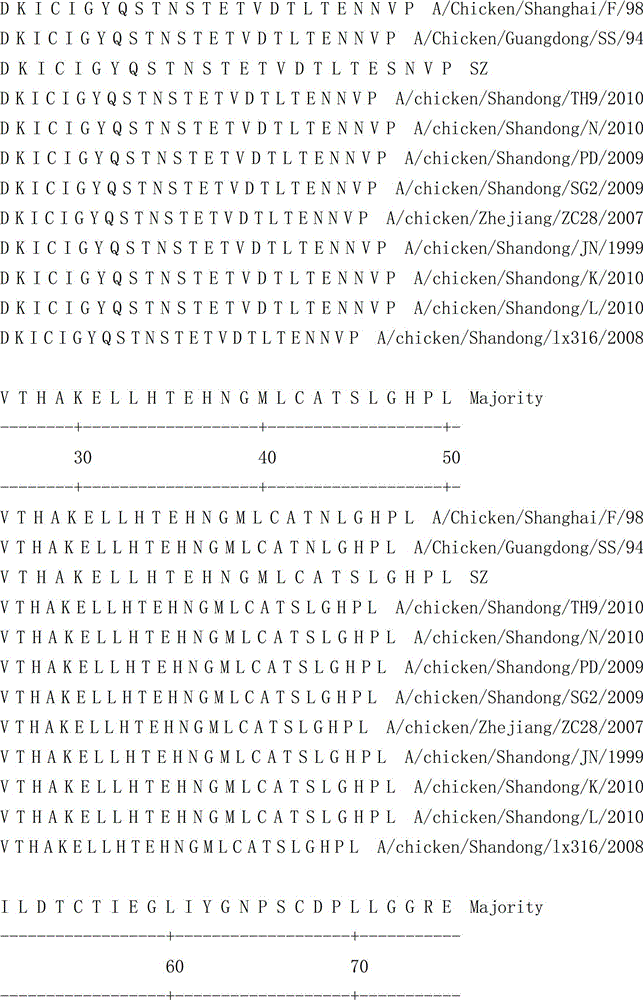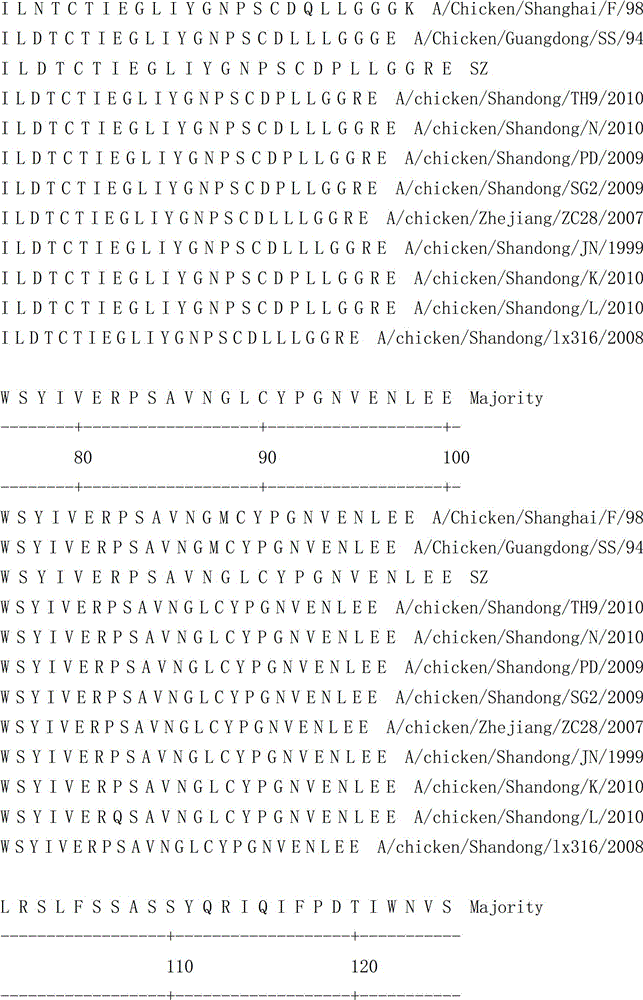H9 subtype avian influenza virus isolate and vaccine composition prepared therefrom
A technology of avian influenza virus and vaccine composition, which is applied in the field of poultry biopharmaceuticals, can solve the problems such as the decline of immune protection efficacy of vaccine strains, and achieve the effects of significant cross-immunogen characteristics, good application prospects, and good immune efficacy
- Summary
- Abstract
- Description
- Claims
- Application Information
AI Technical Summary
Problems solved by technology
Method used
Image
Examples
example 1
[0026] Example 1: Isolation and identification of virus strains
[0027] In 2008, throat and cloacal swabs were collected from broiler chickens in Zhucheng, Shandong, placed in virus preservation solution (10,000 U of penicillin and 2,000 μg of streptomycin per ml, pH: 7.0), and frozen at -20°C. After the swab samples were processed, they were inoculated with 10-day-old SPF chicken embryos (Beijing Meria Weitong Experimental Animal Co., Ltd.). The harvested chicken embryo fluid samples were tested for hemagglutination with 1% chicken red blood cell suspension, the positive samples were prepared with 4 units of antigen, and then the 4 positive sera of H9 AIV, H5 AIV, EDS and ND passed the hemagglutination inhibition (HI) test After serological identification, it was confirmed as H9 subtype AIV. Take the virus liquid and use the virus RNA extraction kit to extract RNA, and reverse transcribe the cDNA. The reverse transcription primer sequence is: 5'-AGCAAAAGCAGG-3'. PCR amplif...
example 2
[0040] Example 2: Vaccine Composition Preparation
[0041] 1. Preparation of virus fluid
[0042] Get H9 subtype avian influenza virus SZ strain (CCTCC V201240) virus seeds, dilute to 10 with sterile normal saline -3 (Take 0.1ml of the virus liquid and add it to 0.9ml of sterile saline, shake and mix, and then dilute twice accordingly), and inoculate 10-day-old susceptible chicken embryos through the allantoic cavity (purchased from Beijing Merial Verton Experimental Co., Ltd. SPF eggs from Animal Technology Co., Ltd. self-hatch), 0.1ml per embryo (including 10 5 EID 50 ). Seal the pinhole after inoculation, and continue to incubate at 36-37°C without turning the eggs. After 96 hours, take it out, put the air chamber upright, and cool it at 2-8°C for 12-24 hours. Harvest the embryonic liquid from the cooled chicken embryos. The harvested virus liquid sampling, according to the method in appendix 7 of " Veterinary Pharmacopoeia of the People's Republic of China " (2010 ed...
example 3
[0065] Example 3: Strain Cross Immunogenicity
[0066] For researching the cross-protection of H9 subtype avian influenza virus SZ strain (CCTCC V201240) to other strains, according to the preparation method of vaccine in example 2, prepared avian influenza (H9 subtype) inactivated vaccine (HL strain) respectively ( HL strain inactivated vaccine for short), avian influenza (H9 subtype) inactivated vaccine (SZ strain) (referred to as SZ strain inactivated vaccine), and containing two antigens of HL and SZ (antigen ratio is 1:1, V / The inactivated vaccine of V) (being called for short HL+SZ strain inactivated vaccine), immunizes SPF chicken (purchased from Beijing Meria Weitong Experimental Animal Technology Co., Ltd.) respectively, chooses HL strain and SZ strain to attack respectively 3 weeks after immunization, and Perform virus isolation. The results showed that the virus shedding rates of the HL strain inactivated vaccine immunization group were 0 / 10 and 4 / 10 respectively,...
PUM
 Login to View More
Login to View More Abstract
Description
Claims
Application Information
 Login to View More
Login to View More - R&D
- Intellectual Property
- Life Sciences
- Materials
- Tech Scout
- Unparalleled Data Quality
- Higher Quality Content
- 60% Fewer Hallucinations
Browse by: Latest US Patents, China's latest patents, Technical Efficacy Thesaurus, Application Domain, Technology Topic, Popular Technical Reports.
© 2025 PatSnap. All rights reserved.Legal|Privacy policy|Modern Slavery Act Transparency Statement|Sitemap|About US| Contact US: help@patsnap.com



